Factors Influencing Consumer Buying Decisions: A Comprehensive Report
VerifiedAdded on 2019/12/04
|9
|2653
|318
Report
AI Summary
This report provides an in-depth analysis of consumer buying decisions, focusing on the factors that influence purchasing behavior, particularly within the context of private label food brands. It delves into three key theoretical frameworks: utility theory, the black box model, and indifference preferences. The utility theory emphasizes the role of price and marginal utility in shaping consumer choices, while the black box model explores the internal processes that mediate consumer responses to marketing stimuli. The indifference preferences theory highlights the importance of income and price constraints on purchasing decisions. The report examines how these theories apply to consumer behavior, particularly in relation to food products, and highlights how factors such as price, income, and individual preferences influence buying behavior. The report concludes by synthesizing the insights gained from each theory, emphasizing the interplay of various factors in the consumer decision-making process.
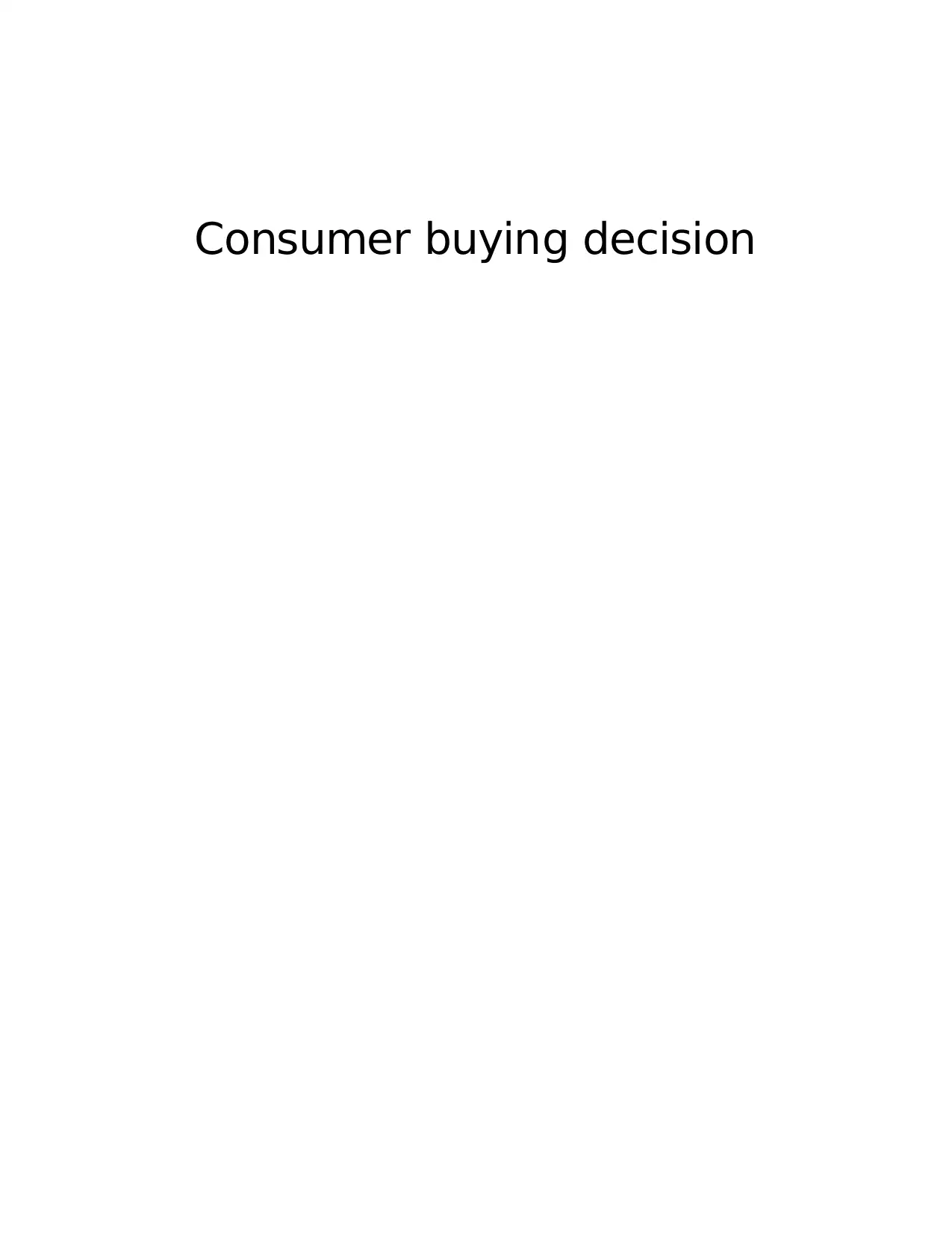
Consumer buying decision
Paraphrase This Document
Need a fresh take? Get an instant paraphrase of this document with our AI Paraphraser
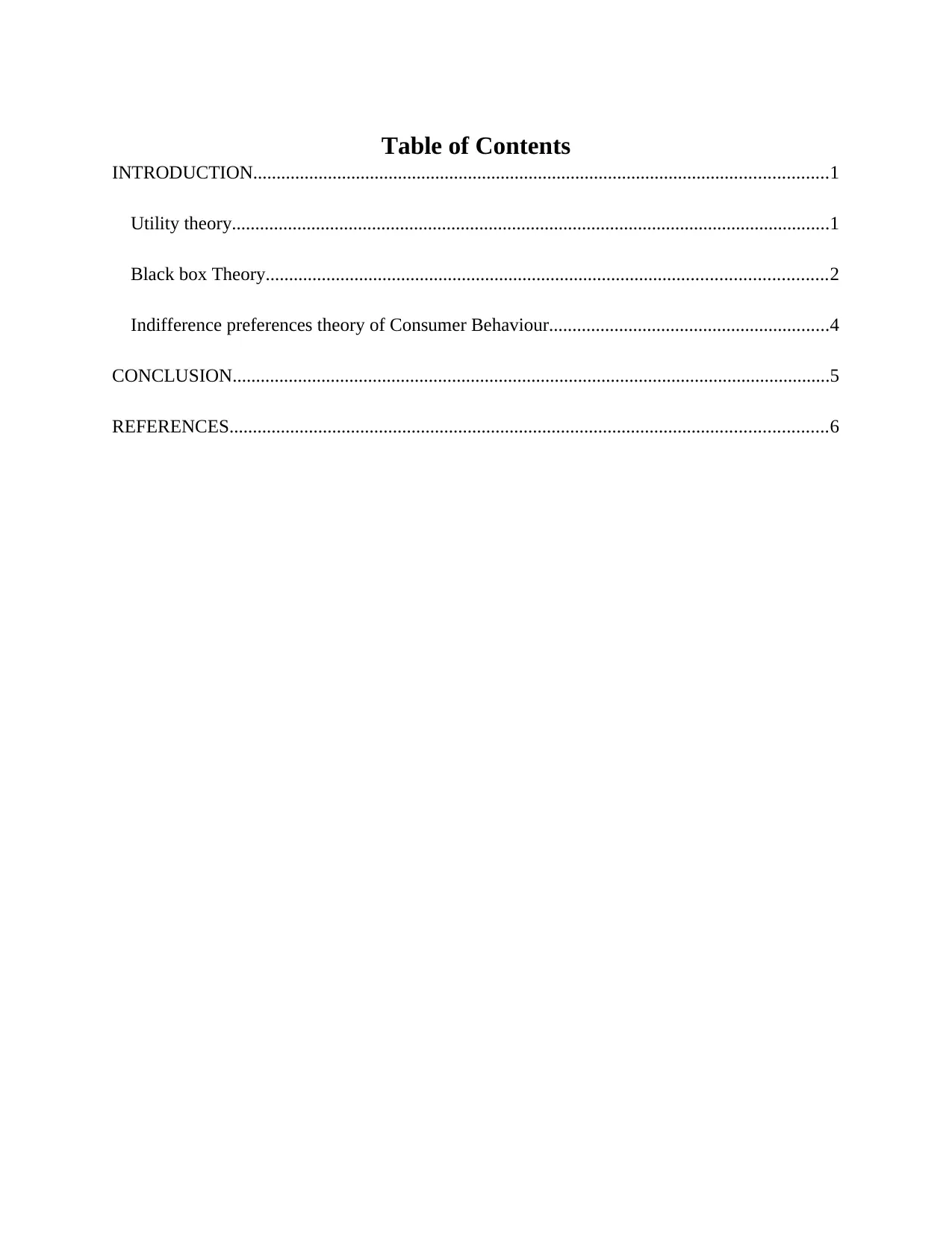
Table of Contents
INTRODUCTION...........................................................................................................................1
Utility theory................................................................................................................................1
Black box Theory........................................................................................................................2
Indifference preferences theory of Consumer Behaviour............................................................4
CONCLUSION................................................................................................................................5
REFERENCES................................................................................................................................6
INTRODUCTION...........................................................................................................................1
Utility theory................................................................................................................................1
Black box Theory........................................................................................................................2
Indifference preferences theory of Consumer Behaviour............................................................4
CONCLUSION................................................................................................................................5
REFERENCES................................................................................................................................6
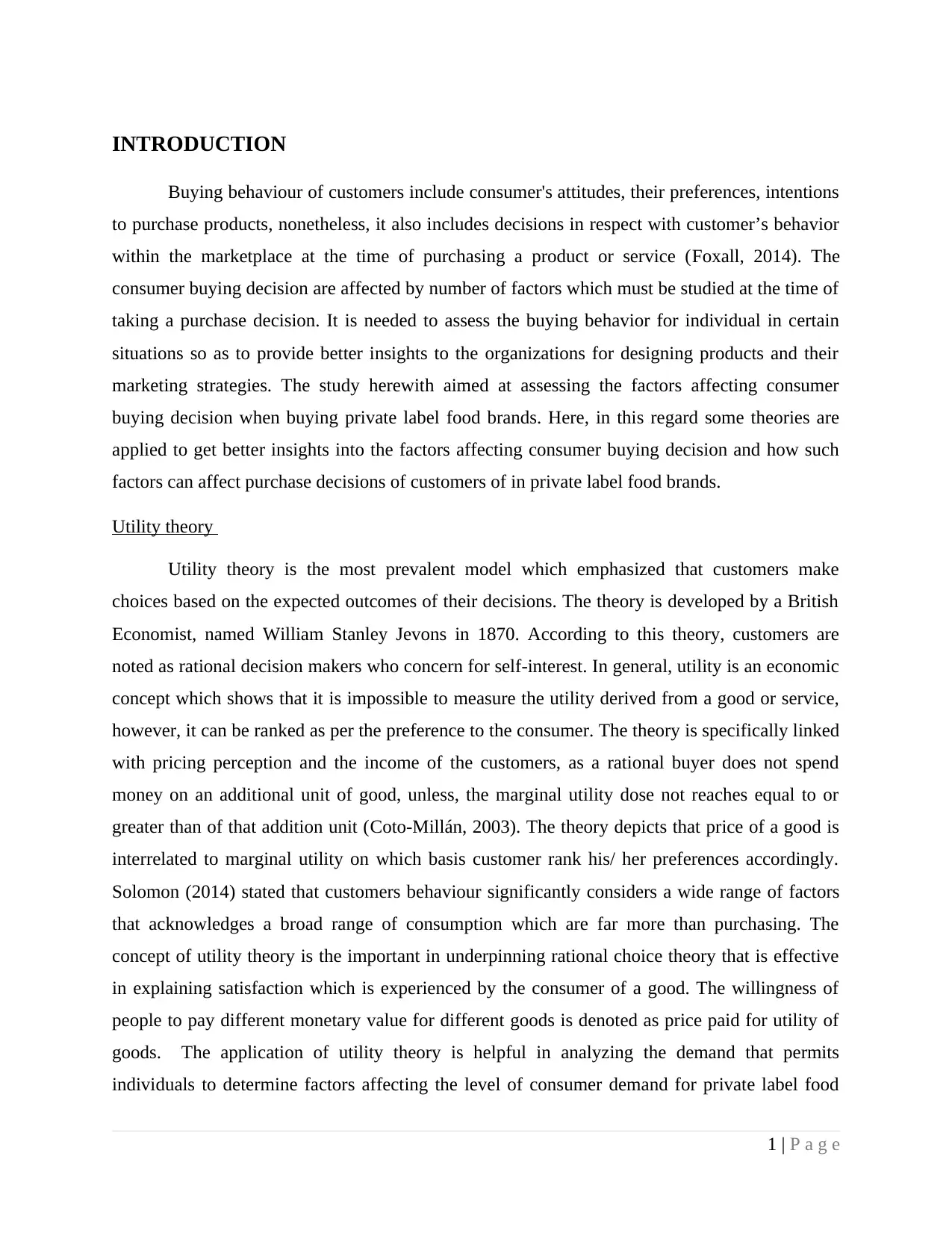
INTRODUCTION
Buying behaviour of customers include consumer's attitudes, their preferences, intentions
to purchase products, nonetheless, it also includes decisions in respect with customer’s behavior
within the marketplace at the time of purchasing a product or service (Foxall, 2014). The
consumer buying decision are affected by number of factors which must be studied at the time of
taking a purchase decision. It is needed to assess the buying behavior for individual in certain
situations so as to provide better insights to the organizations for designing products and their
marketing strategies. The study herewith aimed at assessing the factors affecting consumer
buying decision when buying private label food brands. Here, in this regard some theories are
applied to get better insights into the factors affecting consumer buying decision and how such
factors can affect purchase decisions of customers of in private label food brands.
Utility theory
Utility theory is the most prevalent model which emphasized that customers make
choices based on the expected outcomes of their decisions. The theory is developed by a British
Economist, named William Stanley Jevons in 1870. According to this theory, customers are
noted as rational decision makers who concern for self-interest. In general, utility is an economic
concept which shows that it is impossible to measure the utility derived from a good or service,
however, it can be ranked as per the preference to the consumer. The theory is specifically linked
with pricing perception and the income of the customers, as a rational buyer does not spend
money on an additional unit of good, unless, the marginal utility dose not reaches equal to or
greater than of that addition unit (Coto-Millán, 2003). The theory depicts that price of a good is
interrelated to marginal utility on which basis customer rank his/ her preferences accordingly.
Solomon (2014) stated that customers behaviour significantly considers a wide range of factors
that acknowledges a broad range of consumption which are far more than purchasing. The
concept of utility theory is the important in underpinning rational choice theory that is effective
in explaining satisfaction which is experienced by the consumer of a good. The willingness of
people to pay different monetary value for different goods is denoted as price paid for utility of
goods. The application of utility theory is helpful in analyzing the demand that permits
individuals to determine factors affecting the level of consumer demand for private label food
1 | P a g e
Buying behaviour of customers include consumer's attitudes, their preferences, intentions
to purchase products, nonetheless, it also includes decisions in respect with customer’s behavior
within the marketplace at the time of purchasing a product or service (Foxall, 2014). The
consumer buying decision are affected by number of factors which must be studied at the time of
taking a purchase decision. It is needed to assess the buying behavior for individual in certain
situations so as to provide better insights to the organizations for designing products and their
marketing strategies. The study herewith aimed at assessing the factors affecting consumer
buying decision when buying private label food brands. Here, in this regard some theories are
applied to get better insights into the factors affecting consumer buying decision and how such
factors can affect purchase decisions of customers of in private label food brands.
Utility theory
Utility theory is the most prevalent model which emphasized that customers make
choices based on the expected outcomes of their decisions. The theory is developed by a British
Economist, named William Stanley Jevons in 1870. According to this theory, customers are
noted as rational decision makers who concern for self-interest. In general, utility is an economic
concept which shows that it is impossible to measure the utility derived from a good or service,
however, it can be ranked as per the preference to the consumer. The theory is specifically linked
with pricing perception and the income of the customers, as a rational buyer does not spend
money on an additional unit of good, unless, the marginal utility dose not reaches equal to or
greater than of that addition unit (Coto-Millán, 2003). The theory depicts that price of a good is
interrelated to marginal utility on which basis customer rank his/ her preferences accordingly.
Solomon (2014) stated that customers behaviour significantly considers a wide range of factors
that acknowledges a broad range of consumption which are far more than purchasing. The
concept of utility theory is the important in underpinning rational choice theory that is effective
in explaining satisfaction which is experienced by the consumer of a good. The willingness of
people to pay different monetary value for different goods is denoted as price paid for utility of
goods. The application of utility theory is helpful in analyzing the demand that permits
individuals to determine factors affecting the level of consumer demand for private label food
1 | P a g e
⊘ This is a preview!⊘
Do you want full access?
Subscribe today to unlock all pages.

Trusted by 1+ million students worldwide
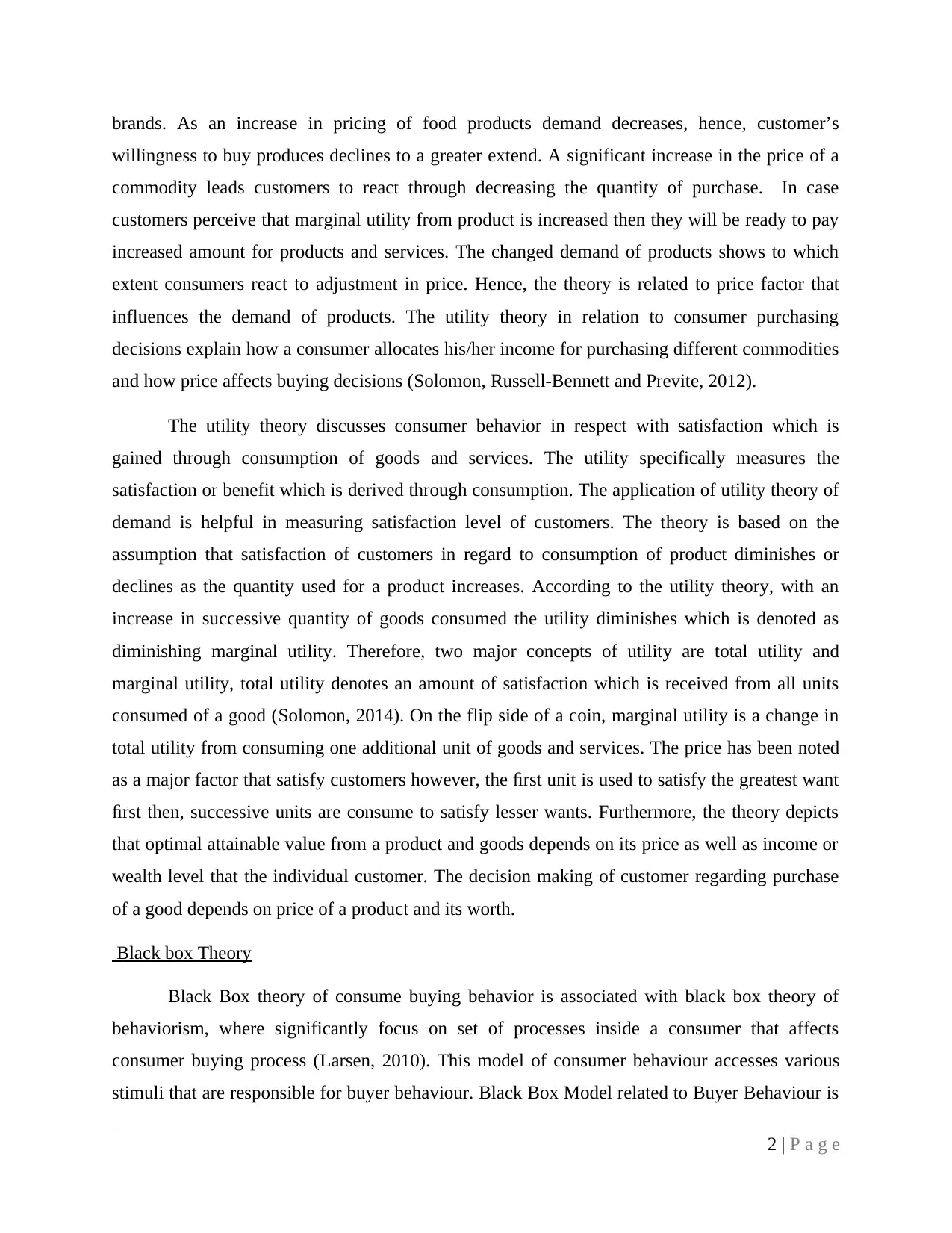
brands. As an increase in pricing of food products demand decreases, hence, customer’s
willingness to buy produces declines to a greater extend. A significant increase in the price of a
commodity leads customers to react through decreasing the quantity of purchase. In case
customers perceive that marginal utility from product is increased then they will be ready to pay
increased amount for products and services. The changed demand of products shows to which
extent consumers react to adjustment in price. Hence, the theory is related to price factor that
influences the demand of products. The utility theory in relation to consumer purchasing
decisions explain how a consumer allocates his/her income for purchasing different commodities
and how price affects buying decisions (Solomon, Russell-Bennett and Previte, 2012).
The utility theory discusses consumer behavior in respect with satisfaction which is
gained through consumption of goods and services. The utility specifically measures the
satisfaction or benefit which is derived through consumption. The application of utility theory of
demand is helpful in measuring satisfaction level of customers. The theory is based on the
assumption that satisfaction of customers in regard to consumption of product diminishes or
declines as the quantity used for a product increases. According to the utility theory, with an
increase in successive quantity of goods consumed the utility diminishes which is denoted as
diminishing marginal utility. Therefore, two major concepts of utility are total utility and
marginal utility, total utility denotes an amount of satisfaction which is received from all units
consumed of a good (Solomon, 2014). On the flip side of a coin, marginal utility is a change in
total utility from consuming one additional unit of goods and services. The price has been noted
as a major factor that satisfy customers however, the first unit is used to satisfy the greatest want
first then, successive units are consume to satisfy lesser wants. Furthermore, the theory depicts
that optimal attainable value from a product and goods depends on its price as well as income or
wealth level that the individual customer. The decision making of customer regarding purchase
of a good depends on price of a product and its worth.
Black box Theory
Black Box theory of consume buying behavior is associated with black box theory of
behaviorism, where significantly focus on set of processes inside a consumer that affects
consumer buying process (Larsen, 2010). This model of consumer behaviour accesses various
stimuli that are responsible for buyer behaviour. Black Box Model related to Buyer Behaviour is
2 | P a g e
willingness to buy produces declines to a greater extend. A significant increase in the price of a
commodity leads customers to react through decreasing the quantity of purchase. In case
customers perceive that marginal utility from product is increased then they will be ready to pay
increased amount for products and services. The changed demand of products shows to which
extent consumers react to adjustment in price. Hence, the theory is related to price factor that
influences the demand of products. The utility theory in relation to consumer purchasing
decisions explain how a consumer allocates his/her income for purchasing different commodities
and how price affects buying decisions (Solomon, Russell-Bennett and Previte, 2012).
The utility theory discusses consumer behavior in respect with satisfaction which is
gained through consumption of goods and services. The utility specifically measures the
satisfaction or benefit which is derived through consumption. The application of utility theory of
demand is helpful in measuring satisfaction level of customers. The theory is based on the
assumption that satisfaction of customers in regard to consumption of product diminishes or
declines as the quantity used for a product increases. According to the utility theory, with an
increase in successive quantity of goods consumed the utility diminishes which is denoted as
diminishing marginal utility. Therefore, two major concepts of utility are total utility and
marginal utility, total utility denotes an amount of satisfaction which is received from all units
consumed of a good (Solomon, 2014). On the flip side of a coin, marginal utility is a change in
total utility from consuming one additional unit of goods and services. The price has been noted
as a major factor that satisfy customers however, the first unit is used to satisfy the greatest want
first then, successive units are consume to satisfy lesser wants. Furthermore, the theory depicts
that optimal attainable value from a product and goods depends on its price as well as income or
wealth level that the individual customer. The decision making of customer regarding purchase
of a good depends on price of a product and its worth.
Black box Theory
Black Box theory of consume buying behavior is associated with black box theory of
behaviorism, where significantly focus on set of processes inside a consumer that affects
consumer buying process (Larsen, 2010). This model of consumer behaviour accesses various
stimuli that are responsible for buyer behaviour. Black Box Model related to Buyer Behaviour is
2 | P a g e
Paraphrase This Document
Need a fresh take? Get an instant paraphrase of this document with our AI Paraphraser
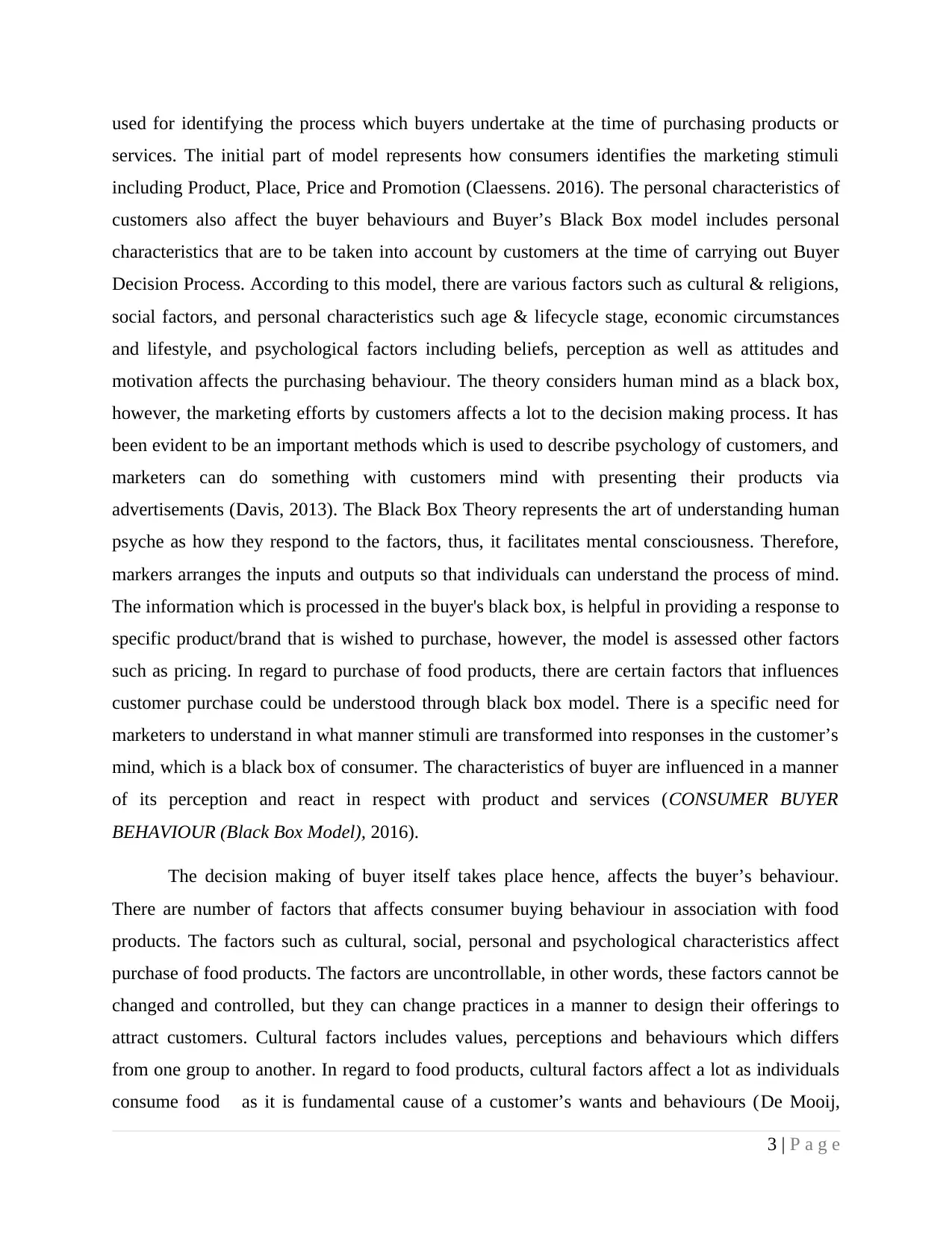
used for identifying the process which buyers undertake at the time of purchasing products or
services. The initial part of model represents how consumers identifies the marketing stimuli
including Product, Place, Price and Promotion (Claessens. 2016). The personal characteristics of
customers also affect the buyer behaviours and Buyer’s Black Box model includes personal
characteristics that are to be taken into account by customers at the time of carrying out Buyer
Decision Process. According to this model, there are various factors such as cultural & religions,
social factors, and personal characteristics such age & lifecycle stage, economic circumstances
and lifestyle, and psychological factors including beliefs, perception as well as attitudes and
motivation affects the purchasing behaviour. The theory considers human mind as a black box,
however, the marketing efforts by customers affects a lot to the decision making process. It has
been evident to be an important methods which is used to describe psychology of customers, and
marketers can do something with customers mind with presenting their products via
advertisements (Davis, 2013). The Black Box Theory represents the art of understanding human
psyche as how they respond to the factors, thus, it facilitates mental consciousness. Therefore,
markers arranges the inputs and outputs so that individuals can understand the process of mind.
The information which is processed in the buyer's black box, is helpful in providing a response to
specific product/brand that is wished to purchase, however, the model is assessed other factors
such as pricing. In regard to purchase of food products, there are certain factors that influences
customer purchase could be understood through black box model. There is a specific need for
marketers to understand in what manner stimuli are transformed into responses in the customer’s
mind, which is a black box of consumer. The characteristics of buyer are influenced in a manner
of its perception and react in respect with product and services (CONSUMER BUYER
BEHAVIOUR (Black Box Model), 2016).
The decision making of buyer itself takes place hence, affects the buyer’s behaviour.
There are number of factors that affects consumer buying behaviour in association with food
products. The factors such as cultural, social, personal and psychological characteristics affect
purchase of food products. The factors are uncontrollable, in other words, these factors cannot be
changed and controlled, but they can change practices in a manner to design their offerings to
attract customers. Cultural factors includes values, perceptions and behaviours which differs
from one group to another. In regard to food products, cultural factors affect a lot as individuals
consume food as it is fundamental cause of a customer’s wants and behaviours (De Mooij,
3 | P a g e
services. The initial part of model represents how consumers identifies the marketing stimuli
including Product, Place, Price and Promotion (Claessens. 2016). The personal characteristics of
customers also affect the buyer behaviours and Buyer’s Black Box model includes personal
characteristics that are to be taken into account by customers at the time of carrying out Buyer
Decision Process. According to this model, there are various factors such as cultural & religions,
social factors, and personal characteristics such age & lifecycle stage, economic circumstances
and lifestyle, and psychological factors including beliefs, perception as well as attitudes and
motivation affects the purchasing behaviour. The theory considers human mind as a black box,
however, the marketing efforts by customers affects a lot to the decision making process. It has
been evident to be an important methods which is used to describe psychology of customers, and
marketers can do something with customers mind with presenting their products via
advertisements (Davis, 2013). The Black Box Theory represents the art of understanding human
psyche as how they respond to the factors, thus, it facilitates mental consciousness. Therefore,
markers arranges the inputs and outputs so that individuals can understand the process of mind.
The information which is processed in the buyer's black box, is helpful in providing a response to
specific product/brand that is wished to purchase, however, the model is assessed other factors
such as pricing. In regard to purchase of food products, there are certain factors that influences
customer purchase could be understood through black box model. There is a specific need for
marketers to understand in what manner stimuli are transformed into responses in the customer’s
mind, which is a black box of consumer. The characteristics of buyer are influenced in a manner
of its perception and react in respect with product and services (CONSUMER BUYER
BEHAVIOUR (Black Box Model), 2016).
The decision making of buyer itself takes place hence, affects the buyer’s behaviour.
There are number of factors that affects consumer buying behaviour in association with food
products. The factors such as cultural, social, personal and psychological characteristics affect
purchase of food products. The factors are uncontrollable, in other words, these factors cannot be
changed and controlled, but they can change practices in a manner to design their offerings to
attract customers. Cultural factors includes values, perceptions and behaviours which differs
from one group to another. In regard to food products, cultural factors affect a lot as individuals
consume food as it is fundamental cause of a customer’s wants and behaviours (De Mooij,
3 | P a g e
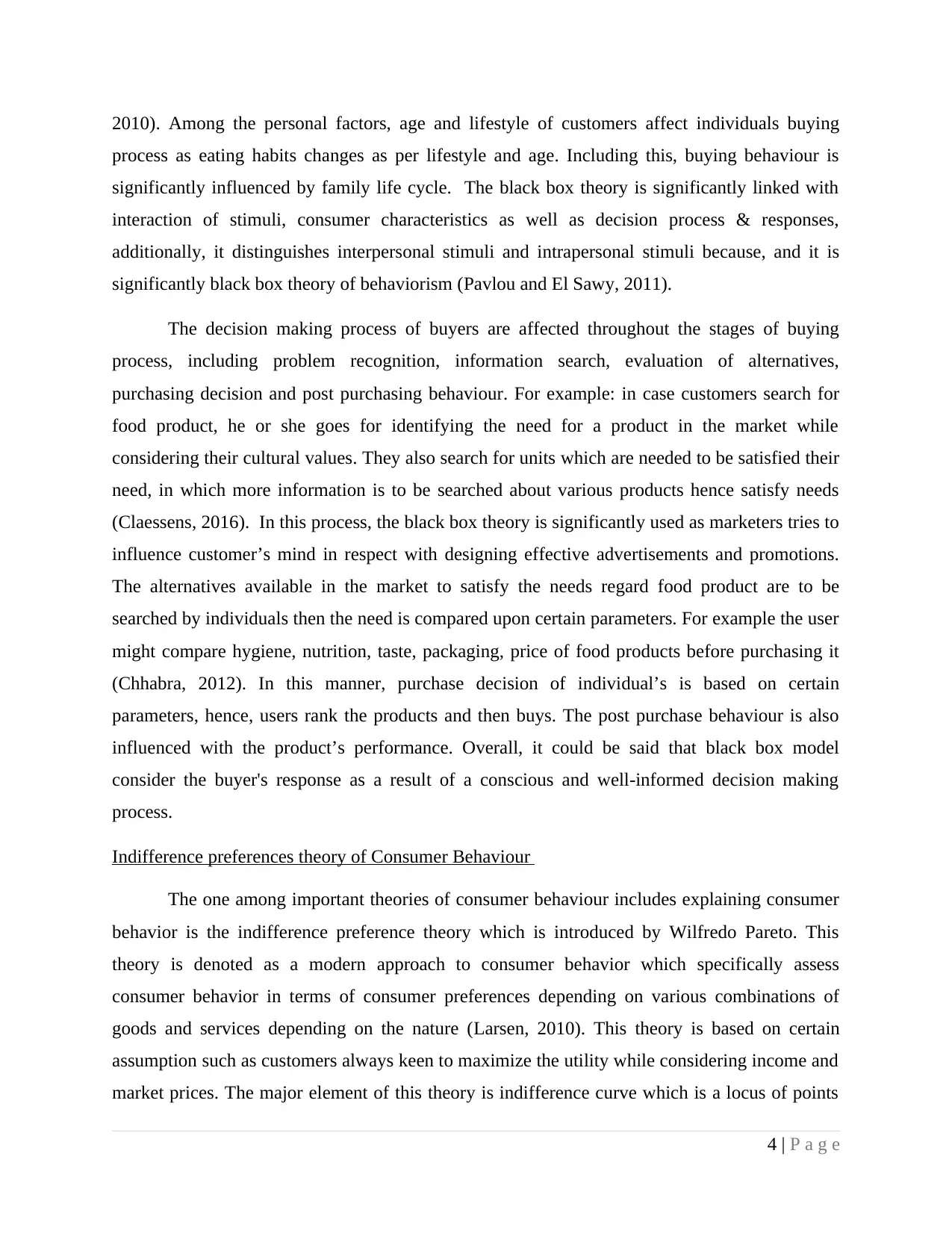
2010). Among the personal factors, age and lifestyle of customers affect individuals buying
process as eating habits changes as per lifestyle and age. Including this, buying behaviour is
significantly influenced by family life cycle. The black box theory is significantly linked with
interaction of stimuli, consumer characteristics as well as decision process & responses,
additionally, it distinguishes interpersonal stimuli and intrapersonal stimuli because, and it is
significantly black box theory of behaviorism (Pavlou and El Sawy, 2011).
The decision making process of buyers are affected throughout the stages of buying
process, including problem recognition, information search, evaluation of alternatives,
purchasing decision and post purchasing behaviour. For example: in case customers search for
food product, he or she goes for identifying the need for a product in the market while
considering their cultural values. They also search for units which are needed to be satisfied their
need, in which more information is to be searched about various products hence satisfy needs
(Claessens, 2016). In this process, the black box theory is significantly used as marketers tries to
influence customer’s mind in respect with designing effective advertisements and promotions.
The alternatives available in the market to satisfy the needs regard food product are to be
searched by individuals then the need is compared upon certain parameters. For example the user
might compare hygiene, nutrition, taste, packaging, price of food products before purchasing it
(Chhabra, 2012). In this manner, purchase decision of individual’s is based on certain
parameters, hence, users rank the products and then buys. The post purchase behaviour is also
influenced with the product’s performance. Overall, it could be said that black box model
consider the buyer's response as a result of a conscious and well-informed decision making
process.
Indifference preferences theory of Consumer Behaviour
The one among important theories of consumer behaviour includes explaining consumer
behavior is the indifference preference theory which is introduced by Wilfredo Pareto. This
theory is denoted as a modern approach to consumer behavior which specifically assess
consumer behavior in terms of consumer preferences depending on various combinations of
goods and services depending on the nature (Larsen, 2010). This theory is based on certain
assumption such as customers always keen to maximize the utility while considering income and
market prices. The major element of this theory is indifference curve which is a locus of points
4 | P a g e
process as eating habits changes as per lifestyle and age. Including this, buying behaviour is
significantly influenced by family life cycle. The black box theory is significantly linked with
interaction of stimuli, consumer characteristics as well as decision process & responses,
additionally, it distinguishes interpersonal stimuli and intrapersonal stimuli because, and it is
significantly black box theory of behaviorism (Pavlou and El Sawy, 2011).
The decision making process of buyers are affected throughout the stages of buying
process, including problem recognition, information search, evaluation of alternatives,
purchasing decision and post purchasing behaviour. For example: in case customers search for
food product, he or she goes for identifying the need for a product in the market while
considering their cultural values. They also search for units which are needed to be satisfied their
need, in which more information is to be searched about various products hence satisfy needs
(Claessens, 2016). In this process, the black box theory is significantly used as marketers tries to
influence customer’s mind in respect with designing effective advertisements and promotions.
The alternatives available in the market to satisfy the needs regard food product are to be
searched by individuals then the need is compared upon certain parameters. For example the user
might compare hygiene, nutrition, taste, packaging, price of food products before purchasing it
(Chhabra, 2012). In this manner, purchase decision of individual’s is based on certain
parameters, hence, users rank the products and then buys. The post purchase behaviour is also
influenced with the product’s performance. Overall, it could be said that black box model
consider the buyer's response as a result of a conscious and well-informed decision making
process.
Indifference preferences theory of Consumer Behaviour
The one among important theories of consumer behaviour includes explaining consumer
behavior is the indifference preference theory which is introduced by Wilfredo Pareto. This
theory is denoted as a modern approach to consumer behavior which specifically assess
consumer behavior in terms of consumer preferences depending on various combinations of
goods and services depending on the nature (Larsen, 2010). This theory is based on certain
assumption such as customers always keen to maximize the utility while considering income and
market prices. The major element of this theory is indifference curve which is a locus of points
4 | P a g e
⊘ This is a preview!⊘
Do you want full access?
Subscribe today to unlock all pages.

Trusted by 1+ million students worldwide
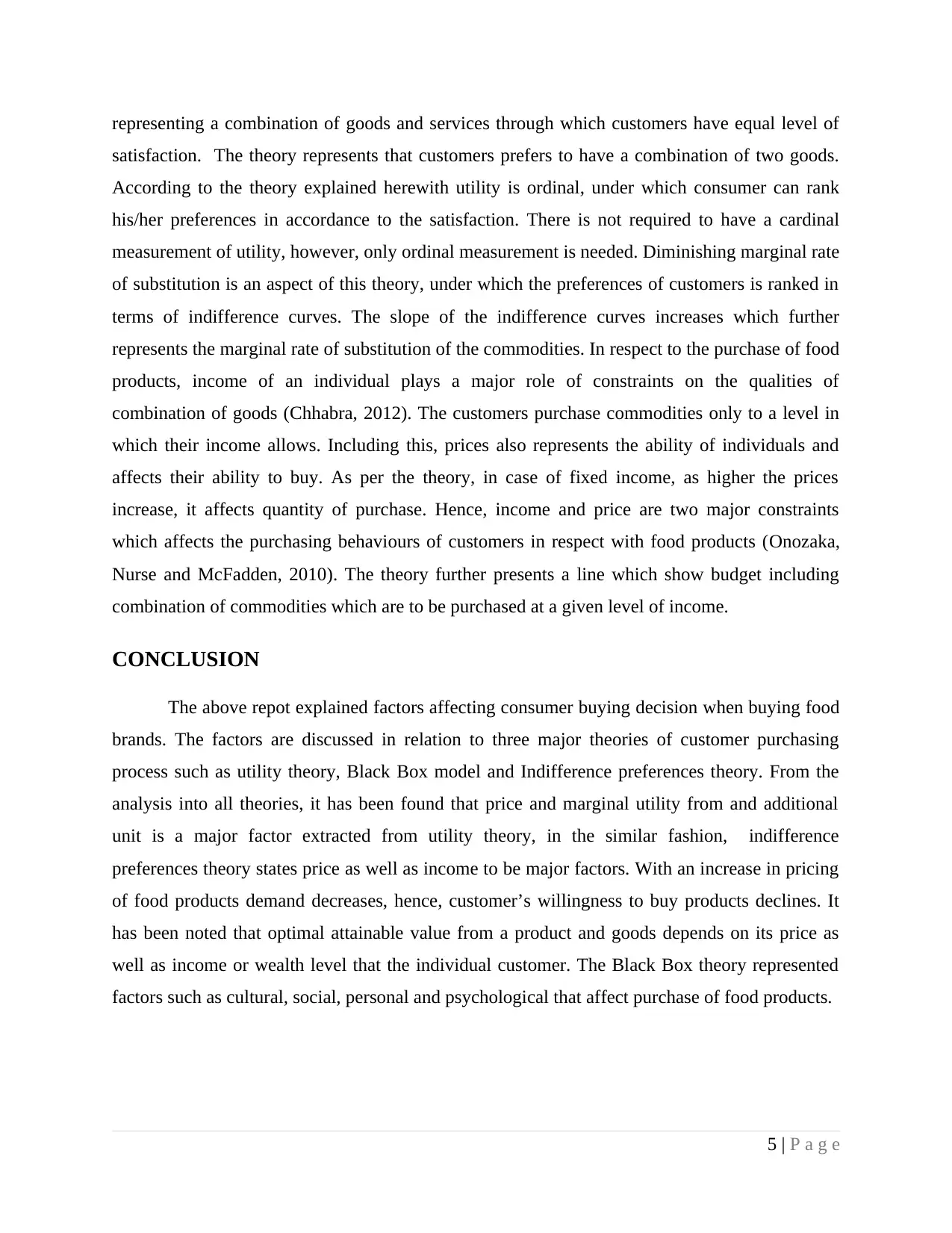
representing a combination of goods and services through which customers have equal level of
satisfaction. The theory represents that customers prefers to have a combination of two goods.
According to the theory explained herewith utility is ordinal, under which consumer can rank
his/her preferences in accordance to the satisfaction. There is not required to have a cardinal
measurement of utility, however, only ordinal measurement is needed. Diminishing marginal rate
of substitution is an aspect of this theory, under which the preferences of customers is ranked in
terms of indifference curves. The slope of the indifference curves increases which further
represents the marginal rate of substitution of the commodities. In respect to the purchase of food
products, income of an individual plays a major role of constraints on the qualities of
combination of goods (Chhabra, 2012). The customers purchase commodities only to a level in
which their income allows. Including this, prices also represents the ability of individuals and
affects their ability to buy. As per the theory, in case of fixed income, as higher the prices
increase, it affects quantity of purchase. Hence, income and price are two major constraints
which affects the purchasing behaviours of customers in respect with food products (Onozaka,
Nurse and McFadden, 2010). The theory further presents a line which show budget including
combination of commodities which are to be purchased at a given level of income.
CONCLUSION
The above repot explained factors affecting consumer buying decision when buying food
brands. The factors are discussed in relation to three major theories of customer purchasing
process such as utility theory, Black Box model and Indifference preferences theory. From the
analysis into all theories, it has been found that price and marginal utility from and additional
unit is a major factor extracted from utility theory, in the similar fashion, indifference
preferences theory states price as well as income to be major factors. With an increase in pricing
of food products demand decreases, hence, customer’s willingness to buy products declines. It
has been noted that optimal attainable value from a product and goods depends on its price as
well as income or wealth level that the individual customer. The Black Box theory represented
factors such as cultural, social, personal and psychological that affect purchase of food products.
5 | P a g e
satisfaction. The theory represents that customers prefers to have a combination of two goods.
According to the theory explained herewith utility is ordinal, under which consumer can rank
his/her preferences in accordance to the satisfaction. There is not required to have a cardinal
measurement of utility, however, only ordinal measurement is needed. Diminishing marginal rate
of substitution is an aspect of this theory, under which the preferences of customers is ranked in
terms of indifference curves. The slope of the indifference curves increases which further
represents the marginal rate of substitution of the commodities. In respect to the purchase of food
products, income of an individual plays a major role of constraints on the qualities of
combination of goods (Chhabra, 2012). The customers purchase commodities only to a level in
which their income allows. Including this, prices also represents the ability of individuals and
affects their ability to buy. As per the theory, in case of fixed income, as higher the prices
increase, it affects quantity of purchase. Hence, income and price are two major constraints
which affects the purchasing behaviours of customers in respect with food products (Onozaka,
Nurse and McFadden, 2010). The theory further presents a line which show budget including
combination of commodities which are to be purchased at a given level of income.
CONCLUSION
The above repot explained factors affecting consumer buying decision when buying food
brands. The factors are discussed in relation to three major theories of customer purchasing
process such as utility theory, Black Box model and Indifference preferences theory. From the
analysis into all theories, it has been found that price and marginal utility from and additional
unit is a major factor extracted from utility theory, in the similar fashion, indifference
preferences theory states price as well as income to be major factors. With an increase in pricing
of food products demand decreases, hence, customer’s willingness to buy products declines. It
has been noted that optimal attainable value from a product and goods depends on its price as
well as income or wealth level that the individual customer. The Black Box theory represented
factors such as cultural, social, personal and psychological that affect purchase of food products.
5 | P a g e
Paraphrase This Document
Need a fresh take? Get an instant paraphrase of this document with our AI Paraphraser
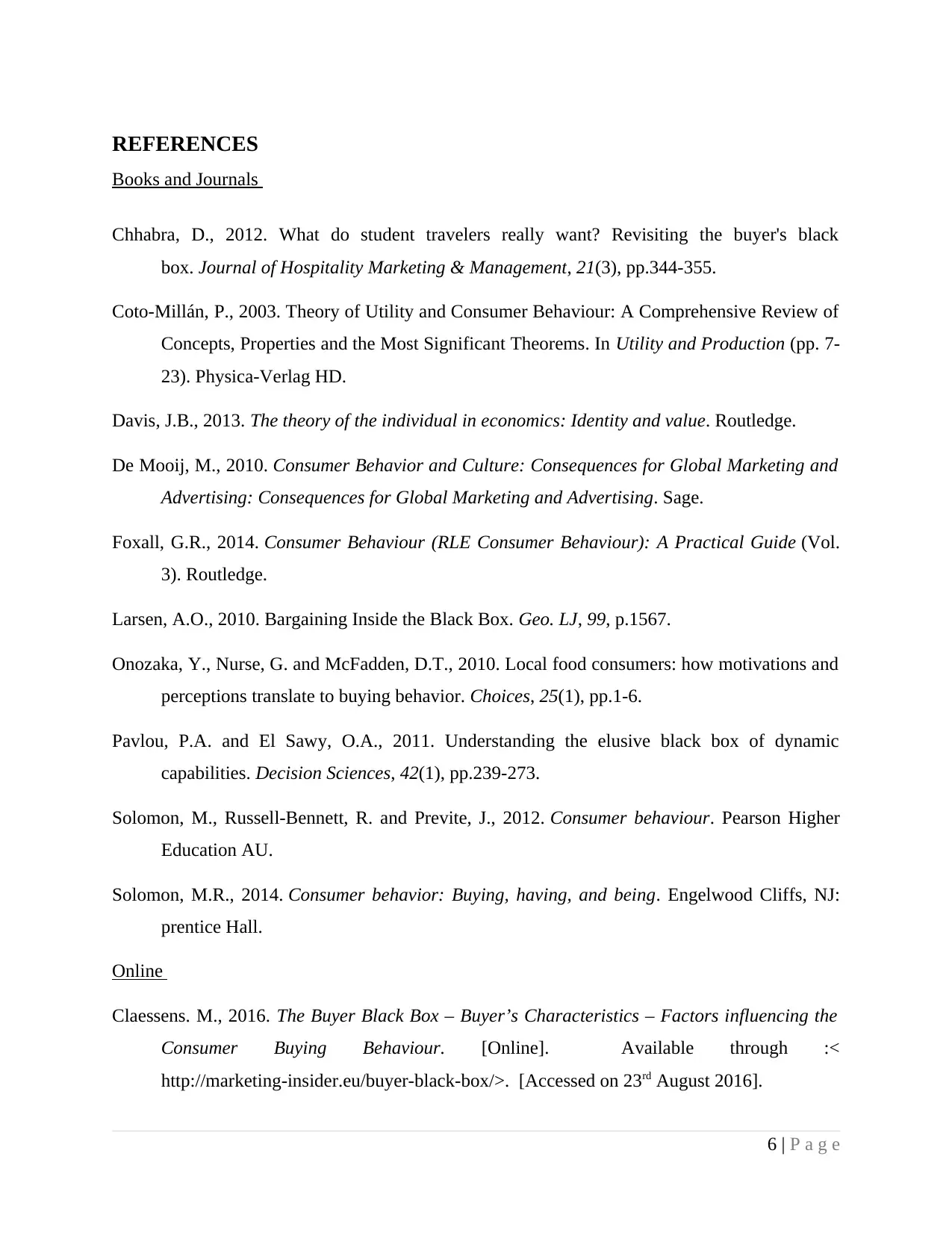
REFERENCES
Books and Journals
Chhabra, D., 2012. What do student travelers really want? Revisiting the buyer's black
box. Journal of Hospitality Marketing & Management, 21(3), pp.344-355.
Coto-Millán, P., 2003. Theory of Utility and Consumer Behaviour: A Comprehensive Review of
Concepts, Properties and the Most Significant Theorems. In Utility and Production (pp. 7-
23). Physica-Verlag HD.
Davis, J.B., 2013. The theory of the individual in economics: Identity and value. Routledge.
De Mooij, M., 2010. Consumer Behavior and Culture: Consequences for Global Marketing and
Advertising: Consequences for Global Marketing and Advertising. Sage.
Foxall, G.R., 2014. Consumer Behaviour (RLE Consumer Behaviour): A Practical Guide (Vol.
3). Routledge.
Larsen, A.O., 2010. Bargaining Inside the Black Box. Geo. LJ, 99, p.1567.
Onozaka, Y., Nurse, G. and McFadden, D.T., 2010. Local food consumers: how motivations and
perceptions translate to buying behavior. Choices, 25(1), pp.1-6.
Pavlou, P.A. and El Sawy, O.A., 2011. Understanding the elusive black box of dynamic
capabilities. Decision Sciences, 42(1), pp.239-273.
Solomon, M., Russell-Bennett, R. and Previte, J., 2012. Consumer behaviour. Pearson Higher
Education AU.
Solomon, M.R., 2014. Consumer behavior: Buying, having, and being. Engelwood Cliffs, NJ:
prentice Hall.
Online
Claessens. M., 2016. The Buyer Black Box – Buyer’s Characteristics – Factors influencing the
Consumer Buying Behaviour. [Online]. Available through :<
http://marketing-insider.eu/buyer-black-box/>. [Accessed on 23rd August 2016].
6 | P a g e
Books and Journals
Chhabra, D., 2012. What do student travelers really want? Revisiting the buyer's black
box. Journal of Hospitality Marketing & Management, 21(3), pp.344-355.
Coto-Millán, P., 2003. Theory of Utility and Consumer Behaviour: A Comprehensive Review of
Concepts, Properties and the Most Significant Theorems. In Utility and Production (pp. 7-
23). Physica-Verlag HD.
Davis, J.B., 2013. The theory of the individual in economics: Identity and value. Routledge.
De Mooij, M., 2010. Consumer Behavior and Culture: Consequences for Global Marketing and
Advertising: Consequences for Global Marketing and Advertising. Sage.
Foxall, G.R., 2014. Consumer Behaviour (RLE Consumer Behaviour): A Practical Guide (Vol.
3). Routledge.
Larsen, A.O., 2010. Bargaining Inside the Black Box. Geo. LJ, 99, p.1567.
Onozaka, Y., Nurse, G. and McFadden, D.T., 2010. Local food consumers: how motivations and
perceptions translate to buying behavior. Choices, 25(1), pp.1-6.
Pavlou, P.A. and El Sawy, O.A., 2011. Understanding the elusive black box of dynamic
capabilities. Decision Sciences, 42(1), pp.239-273.
Solomon, M., Russell-Bennett, R. and Previte, J., 2012. Consumer behaviour. Pearson Higher
Education AU.
Solomon, M.R., 2014. Consumer behavior: Buying, having, and being. Engelwood Cliffs, NJ:
prentice Hall.
Online
Claessens. M., 2016. The Buyer Black Box – Buyer’s Characteristics – Factors influencing the
Consumer Buying Behaviour. [Online]. Available through :<
http://marketing-insider.eu/buyer-black-box/>. [Accessed on 23rd August 2016].
6 | P a g e
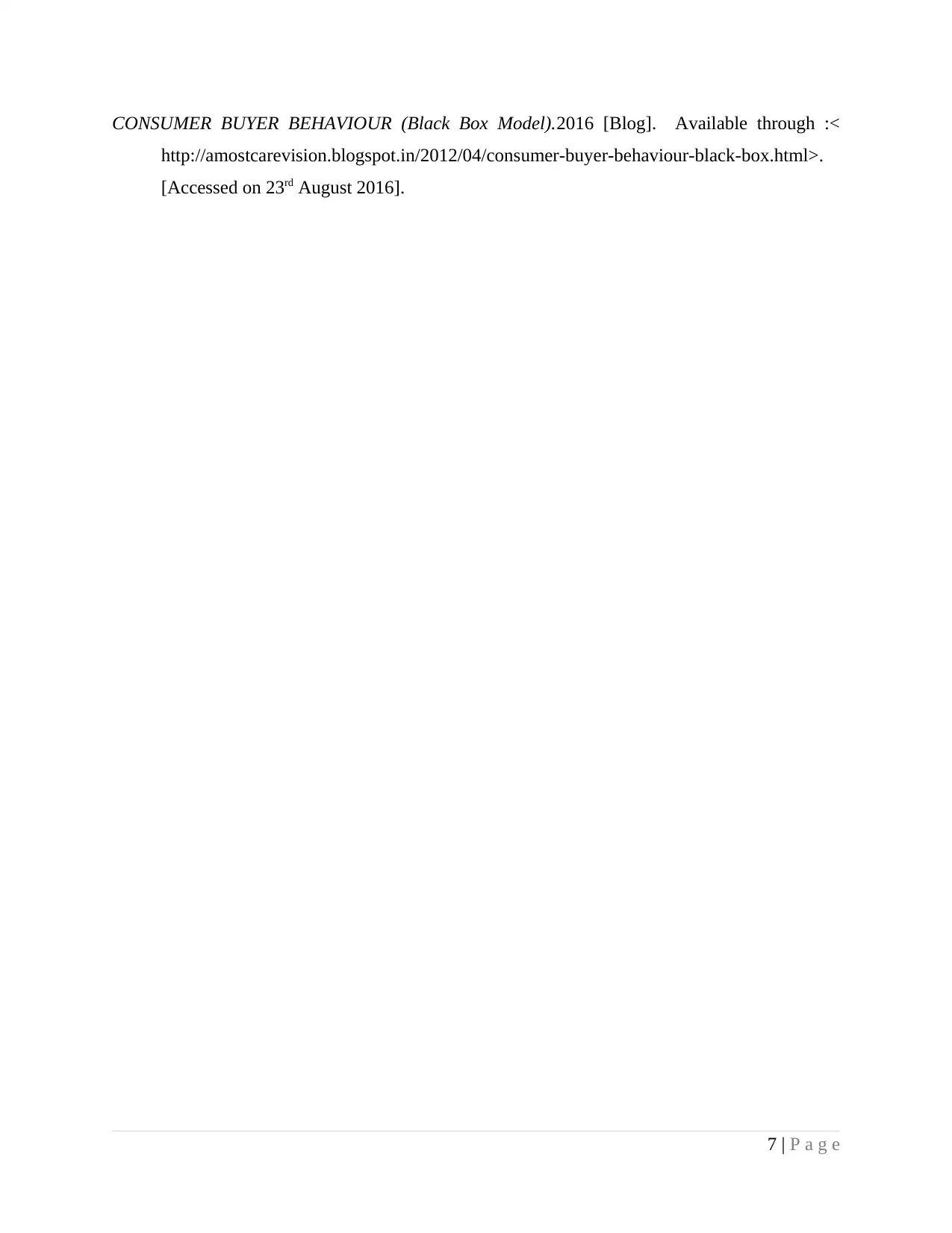
CONSUMER BUYER BEHAVIOUR (Black Box Model).2016 [Blog]. Available through :<
http://amostcarevision.blogspot.in/2012/04/consumer-buyer-behaviour-black-box.html>.
[Accessed on 23rd August 2016].
7 | P a g e
http://amostcarevision.blogspot.in/2012/04/consumer-buyer-behaviour-black-box.html>.
[Accessed on 23rd August 2016].
7 | P a g e
⊘ This is a preview!⊘
Do you want full access?
Subscribe today to unlock all pages.

Trusted by 1+ million students worldwide
1 out of 9
Related Documents
Your All-in-One AI-Powered Toolkit for Academic Success.
+13062052269
info@desklib.com
Available 24*7 on WhatsApp / Email
![[object Object]](/_next/static/media/star-bottom.7253800d.svg)
Unlock your academic potential
Copyright © 2020–2026 A2Z Services. All Rights Reserved. Developed and managed by ZUCOL.





